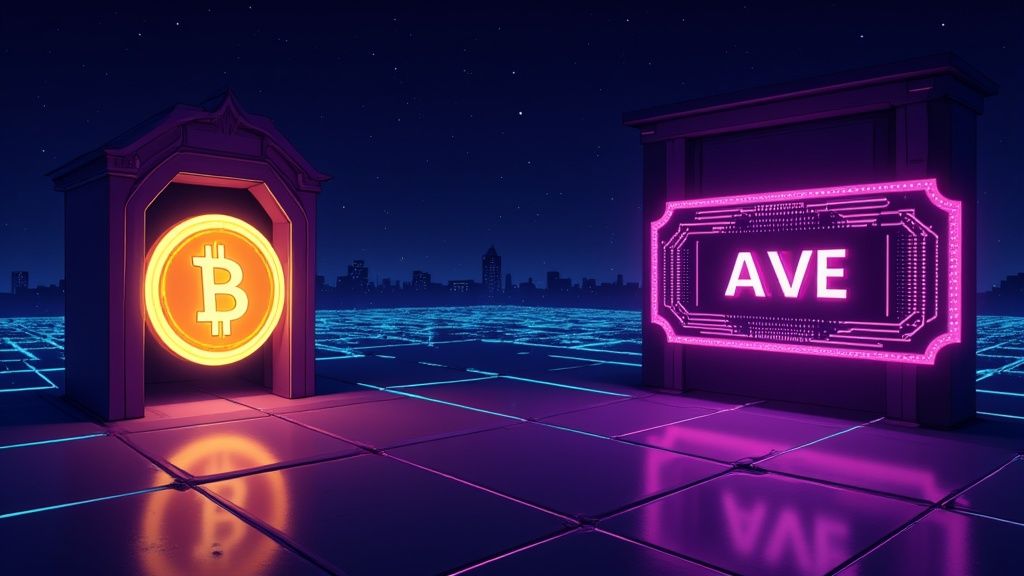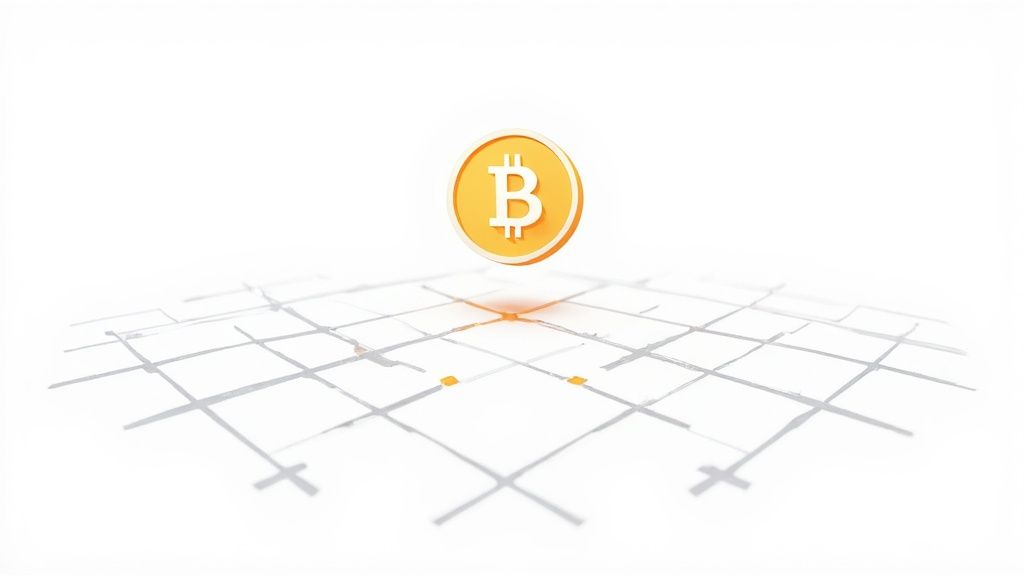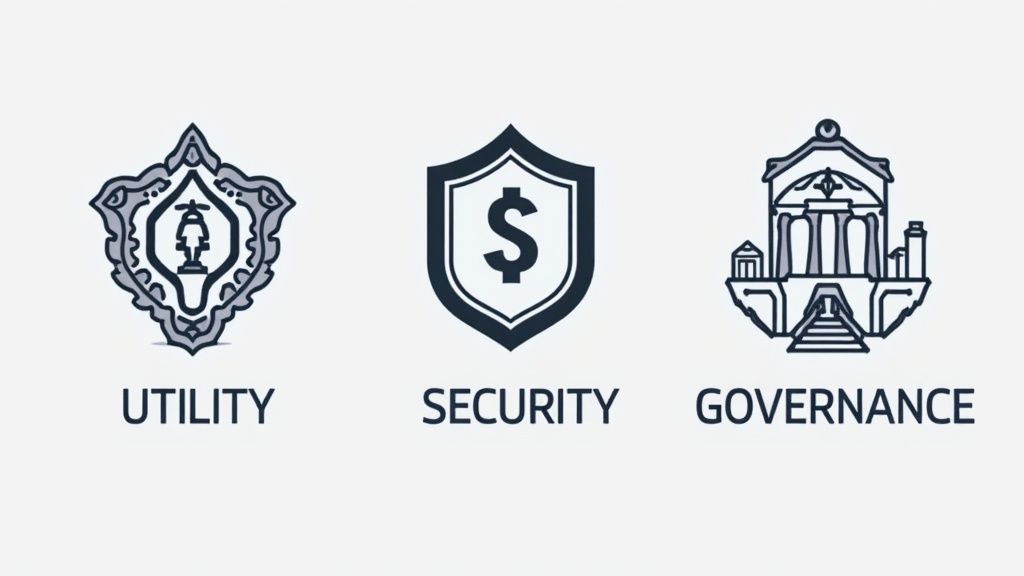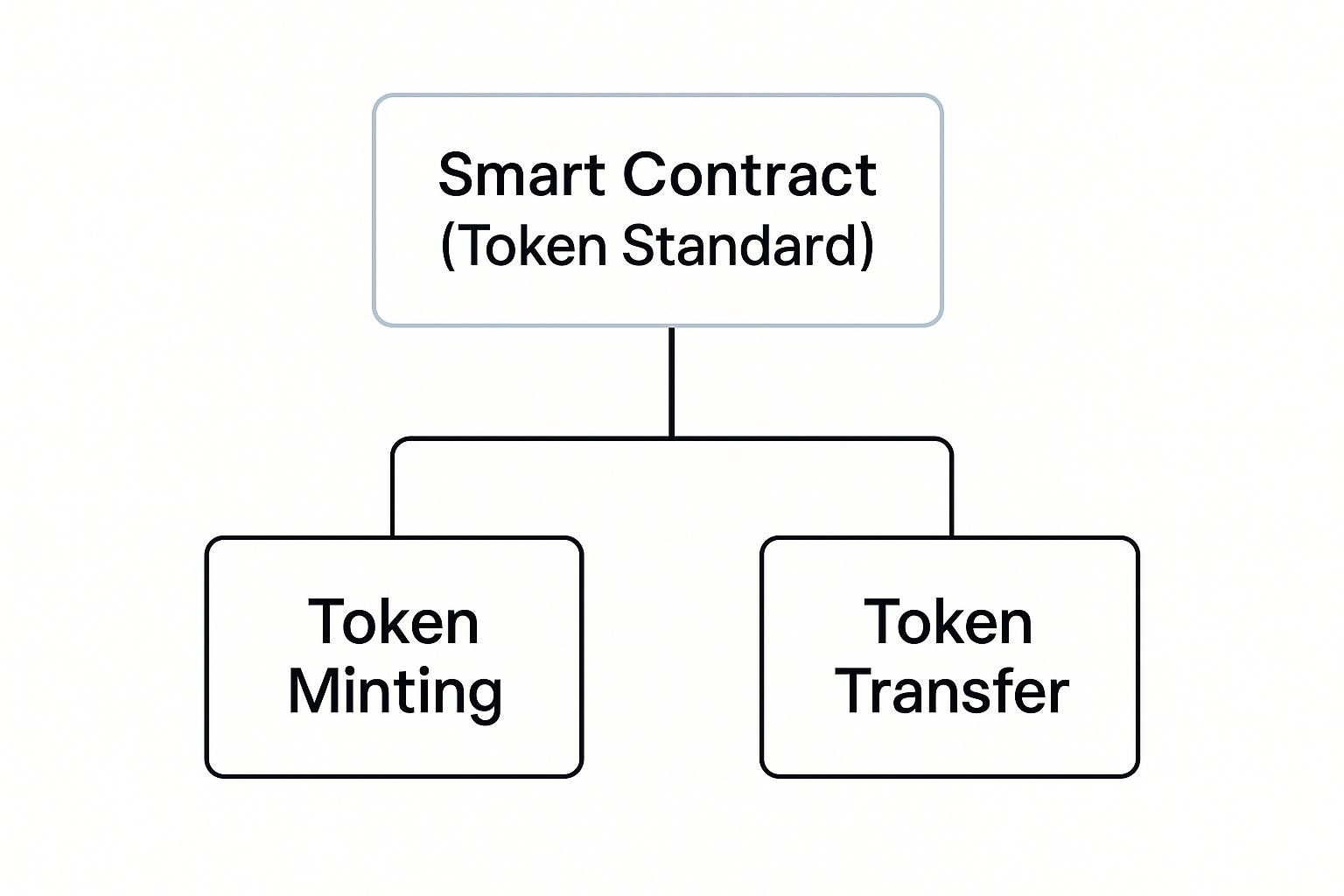What Are Tokens in Cryptocurrency Explained

Alright, let's dive into the world of crypto tokens. If you've been around the space for a bit, you've probably heard the words "coin" and "token" thrown around interchangeably. But they're not the same thing, and knowing the difference is key to understanding how this all works.
So, what exactly is a token? Think of it as a digital asset that lives on another blockchain. It doesn't have its own dedicated network; instead, it's built on top of an existing one, like Ethereum. Tokens can represent just about anything you can imagine, from a membership pass to a share in a company.
Decoding Your First Crypto Token

Feeling a little lost? Don't worry, you're not alone. The coin vs. token thing trips up a lot of newcomers. Let's break it down with a simple analogy.
Imagine a blockchain is like a massive, shared amusement park—let's call it Ethereum Land. A cryptocurrency coin, like Ether (ETH), is the park's official currency. You use it to buy tickets, get food, and pay for everything inside the park. It's the native money of that entire ecosystem.
A token, on the other hand, is like a special ticket for a single ride. You still need the park's main currency (ETH) to buy this special ticket, but once you have it, it grants you access to a specific attraction, like the "DeFi Rollercoaster." That's all it does. It serves one particular function within the larger park.
The Core Difference at a Glance
This distinction is what really defines their purpose. Coins are meant to act as digital money or a store of value. Tokens are built to do a specific job for a particular project or application.
In a nutshell, crypto tokens are digital assets created on an existing blockchain using smart contracts. This flexibility allows them to power a huge range of applications that go way beyond simple currency.
This versatility is a big reason why the crypto market has exploded. As of 2024, the market hit a valuation of around USD 5.7 billion, and token-based projects are a massive driver of that growth. If you want to dive deeper into the basics, you can explore fundamental crypto concepts in the vtrader.io Academy.
To really nail down the differences, here’s a quick side-by-side comparison.
Quick Look Coins vs Tokens
| Characteristic | Cryptocurrency Coins (e.g., Bitcoin) | Cryptocurrency Tokens (e.g., UNI) |
|---|---|---|
| Blockchain | Run on their own native blockchain. | Piggyback on an existing blockchain (like Ethereum). |
| Primary Use | Function as digital money or a store of value. | Grant access to a specific app, utility, or right. |
| Creation | New coins are "mined" or validated by the network. | Projects issue them through a smart contract. |
This table makes it easy to see that while they both live on the blockchain, their architecture and purpose are fundamentally different. Understanding this is your first real step from being a crypto beginner to someone who genuinely gets it.
Exploring the Difference Between Coins and Tokens

So, we've got the arcade analogy down, but the real distinction between a crypto coin and a token runs much deeper. It’s a difference that dictates everything from how they’re made to what they’re actually for. The key word here is autonomy.
A cryptocurrency coin is the native currency of its very own blockchain. Think Bitcoin (BTC) on the Bitcoin blockchain, or Ether (ETH) on the Ethereum blockchain. These coins are the essential fuel that keeps their networks running.
Because they’re native, coins have some pretty fundamental jobs. They’re used to pay for transaction fees (what you’ll often hear called "gas" on Ethereum), reward the people who validate transactions and secure the network, and generally serve as the main way to exchange value within that specific ecosystem. A coin is part of the blockchain's core plumbing.
The Foundation Coins Are Built On
Let's try another way to look at it. If a blockchain were a country, the coin would be its official currency—the U.S. Dollar, the Euro, the Yen. It’s issued by the "government" of that country (the blockchain's protocol) and is needed for pretty much all official business.
This tight integration gives coins a few unique traits:
- Self-Sovereignty: Coins don't need another platform to exist. They are the platform.
- Security Role: They're often tied directly into keeping the network secure, like when users "stake" their coins in a Proof-of-Stake system.
- Direct Creation: New coins are usually brought into existence through mining or a similar validation process that’s baked right into the blockchain's code.
Tokens, on the other hand, don't have their own blockchain. They're built by projects on top of an existing blockchain, using smart contracts to set the rules. This is a game-changing difference, and it’s why thousands of different tokens can exist on a single platform like Ethereum.
Tokens: The Apps Built on Blockchains
Here's my favorite analogy. If a blockchain is an operating system like Windows or macOS, then the coin is a core system file—the computer simply won't run without it.
A token, then, is like an application you install on that OS. It could be Photoshop, Spotify, or your favorite video game. Each app does something unique, but they all depend on the underlying operating system to work. They don't have to build a whole new computer from the ground up; they just piggyback on what's already there.
This "build on top" model is what makes tokens so incredibly powerful. It lets developers create all sorts of specialized digital assets without the insane cost and difficulty of building and securing an entirely new blockchain from scratch.
This approach really opens the door for innovation. A small team can focus on building a great product for their users instead of worrying about network infrastructure. They get to borrow all the security and decentralization from the host blockchain, which lets them get their ideas out into the world much, much faster.
This core architectural difference is what really separates them. Coins are usually meant to be a form of digital money. Tokens are designed to represent something else entirely—a membership, a voting right, or access to a specific service. It’s the difference between the foundation and all the cool things you can build on top of it.
The Different Flavors of Crypto Tokens
Now that we've sorted out the difference between coins and tokens, let's dive into the really fun stuff: the incredible variety you'll find in the token world. Tokens aren't just one thing; they're more like a specialized toolkit where every tool is built for a specific job.
Thinking of them as different "flavors" really helps. You wouldn't use a screwdriver to hammer a nail, right? In the same way, you wouldn't use a utility token as a share of ownership. This specialization is exactly what makes them so powerful.
Utility Tokens: The Access Keys
First up, we have utility tokens. You'll run into these most often. The easiest way to think of a utility token is like a digital key or even an arcade token. Its whole purpose is to give you access to a product or service on a specific network.
For example, say there's a decentralized cloud storage service. To actually use their storage, you might need to buy and spend their native utility token. Its value isn't tied to the company's stock price; its value comes from its utility—how useful it is on that one platform.
- Filecoin (FIL): People spend FIL to store their files on its decentralized network. Simple as that.
- Basic Attention Token (BAT): If you use the Brave browser, you can earn BAT for watching privacy-friendly ads and then use it to tip your favorite content creators.
These tokens create a mini-economy within a project, letting users pay for services and creators get paid, all without needing traditional banks.
Security Tokens: The Digital Ownership Stakes
Next are security tokens, and these are a completely different animal. They operate under much stricter rules for a very good reason: a security token is a digital stand-in for ownership in a real-world asset. Think of it as a traditional stock, a bond, or a deed to a property that's been "tokenized" and put on the blockchain.
When you own a security token, you actually own a piece of something tangible or a share in a company's profits. This means they fall under the same financial regulations as their old-school counterparts. For instance, Robinhood recently announced it would offer US stock and ETF tokens in the EU, giving customers a new way to get exposure to US equities.
The key takeaway is this: if a token's value comes from how well the underlying company is doing, and you expect to profit from the work of that company's team, it’s almost certainly a security token.
This is a huge deal because it's making traditional investments much easier to access, trade, and split into smaller pieces on a global scale.
Since Bitcoin kicked things off in 2009, the sheer number of tokens has exploded. The total crypto market cap is projected to hit around $4.17 trillion by late 2025, driven by an incredible 88.15% year-over-year growth. Tokens are a massive part of this. Platforms like Ethereum alone have hosted over 300,000 different tokens since they launched. While the top 11 tokens get most of the attention, thousands of others are quietly powering everything from gaming to finance. You can always discover more insights about the crypto market on CoinGecko to see what's new.
Governance Tokens: The Power to Vote
Governance tokens are all about giving you a voice. In the world of Decentralized Autonomous Organizations (DAOs) and DeFi protocols, these tokens are your voting power. The more tokens you hold, the louder your voice is.
It’s a bit like being a shareholder in a co-op. Token holders can propose changes—like tweaking transaction fees or funding a new feature—and then vote on ideas from others. This model pushes decision-making away from a small, central team and gives it directly to the community.
A perfect example is Uniswap's UNI token. Anyone holding UNI can vote on critical decisions that will shape the future of the decentralized exchange, making sure it grows in a way that benefits its users.
The infographic below shows the basic smart contract functions that make all of this possible, from creating tokens to moving them around.

As you can see, a standard smart contract acts as the blueprint for minting brand-new tokens and handling their transfer between different people.
Non-Fungible Tokens: The Unique Collectibles
Last but not least, we have Non-Fungible Tokens (NFTs). All the other tokens we've talked about are "fungible"—meaning one is the same as any other, just like one dollar bill is interchangeable with another. NFTs are the complete opposite. Each one is a totally unique, one-of-a-kind digital asset.
An NFT is basically a verifiable certificate of ownership for something, whether that's a piece of digital art, a song, a plot of virtual land, or even a concert ticket. That uniqueness is locked onto the blockchain, making it impossible to fake. For the first time, this technology gave us a real way to prove ownership of digital items, solving a problem that’s been around since the internet began.
Common Token Types and Their Purpose
To help tie all this together, here’s a quick summary of the main token categories, what they do, and how you can think about them in real-world terms.
| Token Type | Primary Function | Real-World Example |
|---|---|---|
| Utility Token | Grants access to a network's product or service. | An arcade token or a software license key. |
| Security Token | Represents ownership in a real-world asset. | A digital version of a company stock or a property deed. |
| Governance Token | Gives holders voting rights in a project. | A share in a member-owned co-op. |
| Non-Fungible Token | Proves ownership of a unique digital or physical item. | A signed, one-of-a-kind piece of art. |
Each of these token types unlocks a different possibility, showing just how flexible and creative the crypto space can be.
How Token Standards Create Order
Imagine a world without standard electrical outlets. You'd need a different plug for your laptop in every building you visited. Total chaos, right? That’s exactly the problem token standards solve in the crypto world. They're like universal adapters, making sure everything just works together.
A token standard is essentially a technical blueprint living on a blockchain. It’s a set of rules that dictates how a token is created, what it can do, and how it plays with other applications. Without these shared rules, every developer would build their tokens in a slightly different way, and your crypto wallet would have no idea how to handle them all.
This common framework is the secret sauce that allows wallets, exchanges, and dApps to support thousands of different tokens. They don't need custom code for each one; they just need to support the standard, and they can instantly understand any token built on that blueprint.
ERC-20: The King of Fungible Tokens
When you hear people talking about token standards, ERC-20 is almost always the first one mentioned. This Ethereum standard is the go-to blueprint for creating fungible tokens—the kind where each unit is identical and interchangeable, just like a dollar bill is the same as any other dollar bill.
The ERC-20 standard forces every token’s smart contract to include a basic set of commands. These functions tell the blockchain how to do essential things, like:
- Track the total supply of the token.
- Check how many tokens are in a specific account.
- Move tokens from one wallet to another.
- Give another address permission to spend tokens on your behalf.
By making these functions mandatory, ERC-20 ensures every token built on its framework behaves predictably. It's why you can send UNI, LINK, or any other ERC-20 token to your Ethereum wallet, and it just shows up. The wallet already knows the rules. For a more technical dive, you can find a great ERC-20 smart contract breakdown online.
ERC-721: The Blueprint for Uniqueness
So, ERC-20 is perfect for creating currency-like assets, but it falls flat when it comes to unique, one-of-a-kind items. That's where ERC-721 steps in. This is the standard that kicked off the NFT craze by providing a blueprint for non-fungible tokens.
Unlike its fungible cousin, every single ERC-721 token is completely unique and has its own distinct ID. This makes it the perfect fit for representing ownership of things like:
- Digital art
- Virtual land in a metaverse
- Special in-game items
- Concert tickets
The whole point of the ERC-721 standard is its ability to track the ownership of each individual token. It can definitively answer the question, "Who owns token #47?" This power to prove ownership of a specific digital asset is what gives NFTs their real value.

As you can see, these standards are community-driven proposals that become widely adopted because they are so useful, creating a common language that all developers can speak.
Hybrid Standards Like ERC-1155
But what if you need both fungible and non-fungible tokens in the same project? This is super common in blockchain gaming. A player might have 100 identical "gold coin" tokens (fungible) and one-of-a-kind "legendary sword" token (non-fungible).
Creating separate contracts for each type would be a nightmare and incredibly inefficient. This is precisely the problem the ERC-1155 standard was built to solve. It’s a "multi-token" standard that can manage any number of both fungible and non-fungible token types all within a single smart contract.
This hybrid approach is way more efficient. It saves a ton on transaction fees and makes a developer's life much easier. A game studio, for example, can create thousands of different items—some interchangeable, some unique—all under one roof. These standards aren't just technical details; they are the core building blocks that make the diverse crypto world possible.
Where Do Cryptocurrency Tokens Come From?
So, where do these tokens actually come from? They don't just appear out of thin air. Unlike coins like Bitcoin, which are "mined" into existence, tokens are created or "minted" using smart contracts.
Think of a smart contract as a digital blueprint or a set of instructions running on an existing blockchain, like Ethereum. A project's developers write the code for this contract, defining everything about their new token: its name, its ticker symbol (like UNI or APE), how many will ever exist, and the rules for how they're created and handed out.
Once that code is deployed to the blockchain, it’s set in stone. It runs automatically, transparently, and without anyone's permission, ready to mint tokens exactly as programmed.
The Grand Opening: A Token Generation Event
This initial creation process has a name: the Token Generation Event (TGE). This is the moment a token is officially born and enters the world. It’s a huge milestone for any project, sort of like a company’s launch day.
If you’re curious about the nitty-gritty of how projects pull this off, our guide on the meaning of a TGE in crypto breaks it all down.
Before the TGE, the team has to map out their entire strategy. They decide on the total supply and figure out how to distribute the tokens. The goal is usually to raise funds for development, reward the early team members, and—most importantly—get the tokens into the hands of the community who will actually use them.
How Tokens Get into Circulation
Once the smart contract is live and the TGE is complete, the tokens need to get out into the wild. A project is dead in the water if all its tokens just sit in the developers' wallets. There are a few tried-and-true methods for this.
- Initial Coin Offering (ICO): This is the crypto version of a stock market IPO. The project sells a chunk of its new tokens to early investors to raise money. That capital then fuels the project's development, marketing, and growth.
- Airdrops: Sometimes, projects just give tokens away for free. They might "airdrop" them to people who have used their platform early on or simply to spread awareness. It’s a fantastic marketing tactic for creating buzz and building a user base right from the start.
Ultimately, a token's creation is a strategic process. From the smart contract's code to the distribution method, every step is designed to build a foundation for the project's long-term success, community engagement, and utility within its ecosystem.
The type of token being created also plays a huge role. We're seeing everything from utility tokens that grant access to a service to security tokens that represent actual ownership. With the explosion of decentralized finance (DeFi), these digital assets are more important than ever, with standards like Ethereum’s ERC-20 acting as the backbone for thousands of new projects.
How Tokens Are Used in the Real World
It's one thing to talk about tokens in theory, but where do they actually show up in our lives? Let's get down to brass tacks and look at how these digital assets are being used by millions of people every day.
These aren't just tickers on a screen; they're the keys to new gaming economies, the ballots for billion-dollar financial protocols, and the stable ground in a notoriously shaky market.
Powering the Next Generation of Gaming
Blockchain gaming is one of the most exciting places to see tokens in action. In these games, utility tokens act as the lifeblood of vibrant, player-owned economies.
Imagine a game where that rare sword you spent weeks grinding for isn't just trapped on a company's server. It’s an NFT you genuinely own. The gold you earn isn't just pretend money; it's a real token you can trade on an open market.
- Axie Infinity (AXS): This is the classic example. Players use AXS tokens for more than just buying in-game items; they use them to vote on the future of the game itself. It completely blurs the line between being a player and being a stakeholder.
- Decentraland (MANA): In this sprawling virtual world, you use the MANA token to buy digital plots of land (which are themselves NFTs) and other goods and services.
This model gives players a true sense of ownership and a real stake in the virtual worlds they love. It's a fundamental shift away from the closed-off ecosystems of traditional gaming.
Giving Communities Control with Governance
Another huge real-world application is in decentralized finance, or DeFi. Here, governance tokens literally hand the keys to the kingdom over to the users.
Think of it like being a member of a co-op instead of just a customer. If you hold the project's governance token, you get a direct vote on how it operates.
It’s a total flip of the traditional corporate model. Instead of a CEO and a board making decisions behind closed doors, the people who actually use the platform vote on everything from fee changes to major software upgrades.
Uniswap, a massive decentralized exchange, is a great example. Holders of its UNI token can propose and vote on changes that impact the entire protocol. This creates a more democratic and transparent system where the platform evolves to serve its community. To get these tokens into the right hands, many projects use airdrops. You can dig deeper into this popular distribution method in our complete guide on how a crypto airdrop works.
Creating Stability in a Volatile Market
Not all tokens are built for taking over the world or running a game. Some have one crucial job: to stay stable. Stablecoins are a unique type of token designed to be a safe harbor in the often-stormy seas of the crypto market.
They are typically pegged to a real-world asset, most often the US dollar. When crypto prices get wild, traders can swap their funds into stablecoins like USDT or USDC to lock in their value without completely cashing out into traditional currency.
Stablecoins have become the bedrock of the entire crypto economy, providing much-needed liquidity and making trading far less chaotic. Their importance can't be overstated. As of mid-2025, the two biggest stablecoins, USDT and USDC, were processing mind-boggling amounts of value. USDT handles over $1 trillion in monthly transaction volume, while USDC's monthly volume fluctuates between $1.24 trillion and $3.29 trillion. These numbers show just how essential they are to the day-to-day functioning of the ecosystem. Discover more insights about these crypto adoption trends from Chainalysis.
Redefining Digital Ownership with NFTs
Finally, no discussion of real-world use is complete without Non-Fungible Tokens (NFTs). By creating a verifiable, one-of-a-kind digital certificate of ownership, NFTs have completely rewritten the rules for digital art, collectibles, and even things like event tickets.
For the first time, a digital artist can sell their work directly to a fan and automatically earn a royalty every time that piece is resold. A collector can prove, without a doubt, that they own the original, not just a screenshot. From digital masterpieces sold at Christie's auction house to concert tickets that are impossible to counterfeit, NFTs are laying a new foundation for what it means to own something in the digital age.
Got Questions About Crypto Tokens? We've Got Answers.
As you get more familiar with the world of crypto tokens, you'll probably start having some questions. It’s totally normal. Let's run through a few of the most common ones that pop up to help you connect the dots.
So, Can Just Anyone Make a Crypto Token?
Believe it or not, yes. Technically, anyone with some coding chops can whip up a new token. Platforms like Ethereum have made it incredibly simple with plug-and-play templates like ERC-20. A developer can essentially define a few key rules—like the token's name, its symbol, and how many will ever exist—and deploy it as a smart contract.
But here’s the catch: creating the token is the easy part. The real mountain to climb is building a legitimate project around it that people actually want to use, fostering a community, and giving the token real, lasting value. That's a whole different ballgame.
Are Tokens a Good Investment?
That's the million-dollar question, isn't it? The honest answer is: it's risky. The crypto market is notoriously wild, and for every token that takes off, countless others fade into obscurity or turn out to be straight-up scams. A token's value is completely dependent on the project behind it—its utility, the demand it generates, and its overall success.
A common piece of advice in the crypto space is to DYOR—Do Your Own Research. Before you even think about investing, you have to dig deep. What's the project's goal? Who is the team behind it? What is the token actually for? And always, always remember the golden rule: never invest more than you can afford to lose.
Understanding these fundamentals helps you make smarter decisions instead of just gambling on price swings.
Where Do I Actually Buy and Trade These Things?
You'll find tokens on cryptocurrency exchanges, which generally fall into two categories. Each one offers a pretty different vibe.
- Centralized Exchanges (CEXs): Think of big names like Coinbase or Kraken. These are run by companies, feel a lot like traditional online brokerage accounts, and usually have customer support. They're a fantastic starting point for beginners.
- Decentralized Exchanges (DEXs): These are platforms like Uniswap that operate on smart contracts, with no middleman. You trade directly from your own wallet, which gives you more control but also means you’re on your own if something goes wrong.
Most people dip their toes in the water with a CEX because they’re just so much easier to get started with. Once you feel more confident, you might find yourself exploring DEXs to discover newer tokens and dive deeper into the DeFi world.
Ready to build a vibrant Web3 community? With Domino, you can design, launch, and scale reward-based quests in minutes, all without writing a single line of code. Accelerate your project's growth and engage your users with automated, on-chain and off-chain tasks. Start building with Domino today!
Level Up Your dApps
Start using Domino in minutes. Use automations created by the others or build your own.
